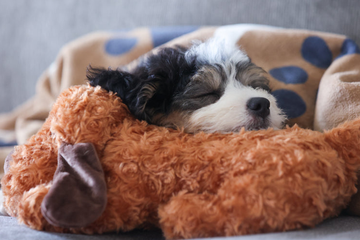The joy of welcoming a puppy into your home is special for everyone – from picturing playtime adventures to dreaming of lazy afternoon cuddles. However, this major life change can be overwhelming for your new furry friend. They're experiencing a disturbance in their world as they leave behind their mother, littermates, and the only environment they've known.
During the first few nights, puppies may show signs of distress through behaviors like whining and restlessness. This is completely normal, as they're adjusting to an unfamiliar place with new sights, sounds, and smells.
Understanding and addressing your puppy's anxiety is crucial for a smooth transition. A heartbeat toy for puppies can provide comfort by mimicking the warmth and soothing rhythm of their mother’s heartbeat, helping to ease their stress and promote better sleep. This guide will share key tips and tricks to help your puppy adjust to their new home smoothly.
Why Puppies Feel Stressed When Moving to a New Home
When your puppy arrives at your home, everything is unfamiliar—new faces, new scents, and a completely different routine. Puppies are creatures of habit; they find security in what they know. The separation from the litter or mother can trigger a sense of confusion and alarm. That initial night without their siblings might feel like an emotional shift for them.
Lack of familiar scents and sounds:
One of the biggest comforts a puppy has is the scent of its mother and siblings. It’s the smell they associate with warmth, food, and affection. As soon as they’re taken to a new location, those comforting smells are replaced with strange ones. Meanwhile, the sounds in your home—from the television to a humming dishwasher—can create sensory overload.
Loss of pack support:
In a litter, puppies rely on each other for warmth and reassurance. They play, cuddle, and even pile on each other to sleep. Without that contact, a puppy might feel uneasy and insecure. Puppies naturally look to their littermates and mothers for cues about whether they are in a safe environment. When those signals suddenly disappear, it can cause panic or restlessness.
New social dynamics
A new home means new people and possibly other pets. Learning the rules of this unfamiliar household can be difficult for them. A puppy might be unsure about which behaviors are acceptable—where they can sleep, what they can chew on, and how to get attention. It’s not just about a physical transition but also learning to communicate in a new setting.
All these factors can leave a puppy feeling stressed, lonely, and prone to crying or whining during the first few days or weeks. Recognizing these stress points will help you address them with empathy and understanding.
How a Heartbeat Toy for Puppies Provides Comfort & Security
Puppies naturally seek warmth and companionship, and this heartbeat toy for puppies into this instinct. Many pet parents have found that this soothing buddy helps their puppies adjust to new environments with less stress and fewer sleepless nights. Puppies that sleep well tend to be less anxious, more sociable, and even easier to train. A well-rested pup is also less prone to destructive behavior, like chewing on furniture or whining throughout the night.
When they snuggle up with this buddy, the warmth and soothing pulses can take them back to a time when they slept in a puppy pile with their mother or siblings. Beyond bedtime, it is valuable during car rides, vet visits, or any situation that might spark anxiety in young dogs. Simply bring this dog toy along so your furry friend has a piece of “home” wherever they go. This companionship reduces the chance of a meltdown in unfamiliar settings.
Moreover, It makes crate training easier. Placing this heartbeat toy inside the crate creates a familiar environment that reduces the puppy’s fear of confinement. Over time, they begin to associate the crate with positive feelings of comfort and security rather than separation from you. This can reduce crying at bedtime or when you leave the house for short errands.
Additional Tips to Overcome Separation Anxiety
Establish a Routine
Puppies thrive with predictability. Setting a consistent schedule for meals, potty breaks, and playtime helps them understand what comes next. This routine builds trust and lessens uncertainty. Try to feed them at the same times each day and take them outside frequently so they learn that their needs will be met.
Create a Cozy Sleeping Area
A designated sleeping spot should feel like a safe haven for them. Make it comfortable with puppy blankets or soft bedding, and place it in a quiet area away from heavy foot traffic but still close enough that your puppy doesn’t feel isolated. Keep the lighting dim at night to mimic the darkness they’d experience when huddled with their littermates.
Gentle Training Sessions
Short, positive training sessions will help your puppy build confidence and strengthen their bond with you. Teach them basic commands like “sit” and “stay,” using treats and praise as rewards. This mental stimulation prevents boredom, which can exacerbate anxiety. Gradually introduce short periods of alone time, starting with just a minute or two, then slowly increasing the duration so they learn that you always return.
Wrapping Up
Comforting a new puppy starts with understanding their emotional and physical needs as they adjust to a big life change. They’re leaving behind familiar scents, their littermates, and a routine they once knew. Creating a secure and predictable environment can help ease their stress and build their confidence.
Another effective way to provide reassurance is with a heartbeat toy for puppies offered by the Calming Buddy. Designed to mimic a sibling's warmth and rhythmic pulse, it helps your puppy feel safe, easing initial fears and promoting long-term emotional well-being.



